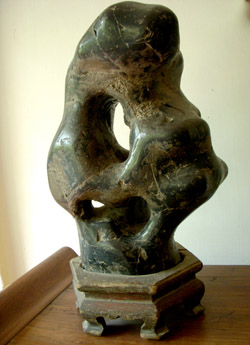Scholar rocks may be seen as condensations of mountains and of the forces that form and structure them. They retain the gestalt or may be felt as memory’s sketch. There is a further magic in the fact that, like mountains, these too are stone, as if a fractal portion of the larger thing.
It is often thought that such stones are simply found by chance and that the chief work lies in mounting. This is true to some extent and mounting is critical in terms of the interpretation and drama given to the presentation. However, human intervention in the shaping of stones is also not uncommon, even as it is obscured by careful finishing. Stones may also be enriched with inscriptions.
The criteria for good stones are varied, corresponding to emotional and philosophical dispositions. Complex forms that rise dramatically from their bases seem to resist gravity and suggest clouds and autonomous forces, while stable and compact rocks represent containment and calm and the subtle authority of discretion.
A great variety of minerals have been treasured as collectable rocks. On a large scale, the grey limestone rocks of Taihu are familiar in gardens, while for desktops the black, iron-rich lingbi stones are prevalent. Less well-known are man-made, carved ‘rocks’ of crystal and glass which are particularly pure and abstract.
| | 
 | 
 |